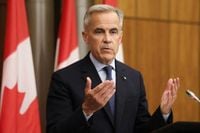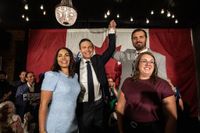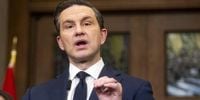Canadian politics is rarely short on drama, but the summer of 2025 has brought a particularly striking blend of high-stakes diplomacy, internal party maneuvering, and even a dash of quantum physics-inspired satire. At the center of it all stands Prime Minister Mark Carney, whose government faces mounting challenges at home and abroad, and Conservative leader Pierre Poilievre, who is both consolidating his grip on his party and preparing for a crucial leadership review.
According to CTV News, Carney’s government recently issued a back-to-work order that has been widely described as his first major blunder since taking office in April. The move drew swift criticism from both political opponents and some of Carney’s own supporters, who saw it as an unforced error that could tarnish his reputation as a steady hand in turbulent times.
Yet, as The Hill Times notes, Carney’s approach to governance has been anything but predictable. Elected on the heels of Donald Trump’s renewed trade hostilities and the specter of U.S. tariffs, Carney has sought to reposition Canada on the world stage. In a marked departure from tradition, his administration is looking to Europe—specifically the Nordic states—for new military and economic alliances. This week, two Canadian ministers embarked on high-profile visits to Sweden and Finland, exploring partnerships with Stockholm and Helsinki’s defense industries as part of a broader push to reduce reliance on the United States.
Foreign Minister Anita Anand’s trip to Finland culminated in the signing of a new strategic cooperation agreement on foreign and security policy with Finnish President Alexander Stubb. According to EUNews, Anand emphasized the urgency of the moment: “Nato’s sight must also shift westwards and northwards due to the changed geopolitical landscape, especially after 24 February 2022.” The Russian invasion of Ukraine, she explained, has forced Canada to rethink its posture in the Arctic, a region made increasingly vulnerable by melting ice caps and heightened Russian activity. “Our priority in terms of Canadian foreign policy in the Arctic is to ensure that nothing is overlooked to protect and defend Canada’s sovereignty,” Anand said, underscoring plans for intensive investment in security infrastructure and new public-private partnerships.
These efforts are more than symbolic. Canada is reportedly considering a further order of 72 F-35 fighter jets, with 16 scheduled for delivery soon, at a cost approaching €12 billion. At the same time, Ottawa is exploring collaboration with Swedish defense giant Saab for the Gripen fighter jet as a potential alternative to the F-35. The defense push extends beyond aircraft: Canadian company Roshel has entered into a partnership with Sweden’s Swebor for the production of ballistic steel, while a Finnish-Canadian joint venture is set to supply a new icebreaker fleet for the Canadian Coast Guard.
All these moves signal a paradigm shift in Canadian foreign policy, one driven by the dual pressures of Russian aggression and U.S. economic unpredictability. The new strategic cooperation agreement with Brussels, which gives Canada access to the EU’s SAFE Fund for joint war procurement, builds on the CETA economic partnership established in 2017. As EUNews puts it, “Canada is rapidly approaching the EU,” a shift made necessary by both external threats and the changing balance of global power.
But if Carney’s international agenda is ambitious, his domestic standing is less secure. Recent polling reported by The Globe and Mail shows Carney with a commanding 27-point lead over Poilievre as the preferred prime minister, according to the latest Nanos survey. However, political observers caution that this advantage may not last. The Liberal lead is attributed in part to the collapse of the New Democratic Party (NDP), but as the NDP’s numbers begin to recover and its leadership race gains momentum, Carney’s honeymoon with voters could be coming to an end.
Meanwhile, Pierre Poilievre is quietly shoring up his position within the Conservative Party. Fresh off a resounding victory in the Battle River-Crowfoot by-election, where he secured around 80% of the vote, Poilievre faces a leadership review in January 2026. As The Globe and Mail notes, “the way things are shaping up, Mr. Poilievre is likely to win that by a large margin as well, meaning he will lead the Conservatives, who have lost four straight federal elections to the Liberals, in the next one.”
Despite the sting of his recent electoral defeat, Poilievre’s grip on the party appears unshakable. There is no credible challenger waiting in the wings, and his support among both caucus members and the party’s populist base remains strong. The absence of any burning policy issue dividing the party further solidifies his standing. Even the party’s progressive elements, who have previously mounted leadership challenges, lack the numbers or the appetite for another contest.
Still, Poilievre faces real risks. Should Carney’s polling lead persist or widen, pressure could mount for a change at the top. For now, though, Conservatives seem content to stick with their leader, in part because “nobody of stature in the party has the courage to take him on,” as The Globe and Mail observes. The party has changed leaders twice in recent years, and there is little appetite for more upheaval.
In Parliament, Poilievre is expected to take a less combative approach, softening his image and sidelining some of his more aggressive advisers. This recalibration is seen as essential if he hopes to chip away at Carney’s lead and present himself as a credible alternative to the Liberal government.
Amidst all this, the Canadian political scene was treated to a dose of levity courtesy of the Perimeter Institute for Theoretical Physics. In a tongue-in-cheek statement, the Institute claimed that Mark Carney’s elbows are in a quantum superposition—neither up nor down, but both at once. Dr. Marcela Carena, director of the institute, quipped, “During the election campaign, we could confidently state that all signs pointed to Carney’s elbows being up, but since then, it has been much more ambiguous.” The analogy, drawing on the famous Schrodinger’s cat paradox, playfully highlights the perceived ambiguity in Carney’s leadership style—sometimes decisive, sometimes conciliatory, and always a bit elusive.
Physicists at the Institute even joked that President Trump’s 35% tariffs on Canadian goods might change their measurements, a nod to the unpredictable and often surreal nature of international politics in 2025. As Dr. Carena put it, “We have also seen one about both standing up for and sitting down for Palestinian rights.” The satire captures a broader truth: in an era of shifting alliances and political uncertainty, even the most seasoned leaders can find themselves in a state of flux.
As Canada heads into a pivotal fall session, the stakes could hardly be higher. With the Arctic opening up, trade wars simmering, and party leaderships on the line, the country’s political future hangs in a delicate—and perhaps quantum—balance.


